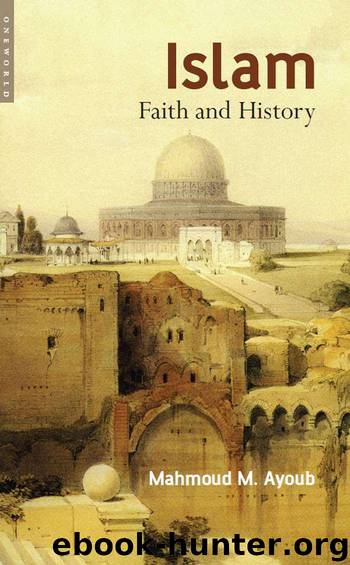Islam: Faith and History by Ayoub Mahmoud M

Author:Ayoub, Mahmoud M. [Ayoub, Mahmoud M.]
Language: eng
Format: azw3
Publisher: Oneworld Publications
Published: 2013-09-30T16:00:00+00:00
THE SIX CANONICAL ḤADĪTH COLLECTIONS
The science of ḥadīth criticism as outlined above was not perfected and fully implemented until the middle of the third/ninth century. It was actually an integral part of the science of jurisprudence and its crowning achievement. The comprehensive works based on it were intended as sources and to some extent, as manuals to be used by later jurists.
The most important Sunni ḥadīth traditionists are Muḥammad b. Isma‘īl al-Bukhārī (d. 870) and Muslim b. al-Ḥajjāj al-Nīsābūrī (d. 875). They were, as their names suggest, from the cities of Bukhārā in Central Asia and Nishāpūr in the province of Khurāsān in northeastern Iran, respectively. Although contemporaries, the two men did not know one another. Yet each of them journeyed for many years across the Muslim world in search of ḥadīth traditions. The two works these long searches produced are amazingly alike, a fact strongly suggestive of an already existing unified and well-established ḥadīth tradition.
Al-Bukhārī and Muslim are each said to have collected hundreds of thousands of ḥadīths out of which they selected about three thousand, discounting repetition. Their methodologies and systems of organization became the criteria that all subsequent ḥadīth compilers followed. Their two collections, entitled simply Ṣaḥīḥ al-Bukhārī and Ṣaḥīḥ Muslim, soon achieved canonical status, second in authority to the Qur’ān. Although the Ṣaḥīḥ of Muslim is better organized and methodologically superior to that of al-Bukhārī, the latter has achieved first place among all ḥadīth collections.
Within less than half a century after Muslim and al-Bukhārī, four other collections, those of Abū Dāwūd al-Sijistānī, Ibn Māja, al-Tirmidhī, and al-Nasā’ī, were produced. It is noteworthy that all four men, like Muslim and al-Bukhārī, were from Central Asia and Iran. Their works are entitled Sunan (pl. of sunnah) and combine the sunnahs of action, consent, and speech. In contrast, the works of Muslim and al-Bukhārī are essentially collections of sound (ṣaḥīḥ.) ḥadīth, as their titles indicate.
The six canonical collections and others modeled on them are organized as legal manuals dealing first with laws governing the rituals of worship, then with the laws regulating the social, political, and economic life of the community. They are divided into books (or sections) beginning with the five pillars of the faith: first, imān and islām, then the prayers (beginning with the rules for ritual cleansing), followed by almsgiving (zakāt), fasting (ṣawm), and pilgrimage (ḥajj). In addition, they treat dietary laws, marriage and divorce, inheritance and related matters. They also include books on jihād, or war, and journeying in God’s way. This section includes laws dealing with the status and treatment of dhimmīs, that is Jews, Christians, and other protected religious communities. Other sections include rules covering criminal acts, trade, and related matters.
Download
This site does not store any files on its server. We only index and link to content provided by other sites. Please contact the content providers to delete copyright contents if any and email us, we'll remove relevant links or contents immediately.
The History of Jihad: From Muhammad to ISIS by Spencer Robert(2509)
Nine Parts of Desire by Geraldine Brooks(2283)
The Turkish Psychedelic Explosion by Daniel Spicer(2247)
The First Muslim The Story of Muhammad by Lesley Hazleton(2159)
The Essential Rumi by Coleman Barks(1932)
1453 by Roger Crowley(1881)
The Last Mughal by William Dalrymple(1797)
Trickster Travels: A Sixteenth-Century Muslim Between Worlds by Davis Natalie Zemon(1785)
Muhammad: His Life Based on the Earliest Sources by Martin Lings(1569)
God by Aslan Reza(1564)
by Christianity & Islam(1564)
A Concise History of Sunnis and Shi'is by John McHugo(1518)
Magic and Divination in Early Islam by Emilie Savage-Smith;(1461)
No God But God by Reza Aslan(1438)
The Flight of the Intellectuals by Berman Paul(1401)
Art of Betrayal by Gordon Corera(1367)
Nothing to Envy by Barbara Demick(1329)
What the Qur'an Meant by Garry Wills(1326)
Getting Jesus Right: How Muslims Get Jesus and Islam Wrong by James A Beverley & Craig A Evans(1279)
